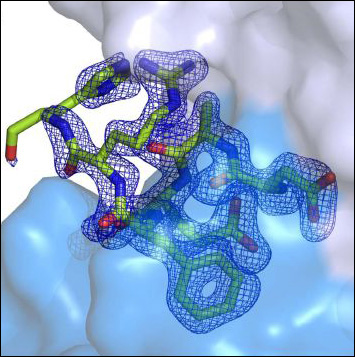Packed in Crystals, Bapineuzumab-Aβ Give Up Secrets
Quick Links
Crystals of a bapineuzumab-Aβ complex may explain how the antibody targets amyloid plaques in the brain, according to researchers in Australia. In the February 18 Scientific Reports, Michael Parker and colleagues at St. Vincent's Institute of Medical Research, Melbourne, report that bapineuzumab, a humanized mouse antibody, captures the N-terminal of Aβ in a helical conformation. This interaction may be unique. In complexes with mouse antibodies, which are used preclinically, the Aβ N-terminal exists as a random coil without secondary structure.
"The thing that distinguishes bapineuzumab from the non-clinical N-terminal antibodies is that it recognizes a conformation-dependent epitope. This was a real surprise, considering everyone was turning up antibodies that consistently see this region as linear," Luke Miles, first author on the paper, told Alzforum via e-mail. "It is therefore plausible that bapineuzumab can distinguish between soluble monomeric Aβ and Aβ in plaques."
In fact, when researchers reported that 3D6, the mouse antibody that provides the backbone for bapineuzumab, preferentially binds plaques, Miles was skeptical (see Seubert et al., 2008). "We knew the N-terminal of Aβ had little structure," he wrote. But now his work shows that Aβ adopts an N-terminal helical structure even without bapineuzumab. Miles found the same helical folding in the presence of TFE, a solvent that promotes intramolecular hydrogen bonds. TFE mimics water loss that might occur when proteins are embedded in membranes or folded in such a way as to eliminate solvent, as in plaques. The authors suggest that plaques are enriched with this helical conformation (see image below) or that it is in equilibrium with other Aβ conformational states in the plaques.

Aβ and Bapineuzumab
Electron density map shows that the Aβ N-terminal (green) adopts an α-helical conformation when bound to bapineuzumab (gray, antibody light chain; blue, antibody heavy chain). Image courtesy of Scientific Reports and Michael Parker
Pfizer and Johnson and Johnson, sponsors of bapineuzumab, halted development of the intravenous version when it had no clinical benefit in a Phase 3 clinical trial of patients with mild to moderate AD (see ARF related news story). Miles and colleagues' finding suggests that bapineuzumab cannot recognize N-terminally modified, or truncated forms of Aβ, because hydrogen bonds essential for the α-helical structure occur among the first three amino acids. Whether that relates to clinical efficacy is unclear. By some estimates, truncated peptides might make up as much as 50 percent of Aβ in the brain.
Other N-terminal-directed antibodies may work differently. Solanezumab, an Aβ antibody that showed a glimmer of success in recent Phase 3 trials, binds the central portion of Aβ (see ARF related news story). Solanezumab will be tested in the upcoming A4 prevention trial (see ARF related news story), and in the DIAN prevention trial along with gantenerumab (see ARF related news story), which purportedly binds both the N-terminal and central regions of Aβ. Crenezumab, which will be put through its paces in the API prevention trial (see ARF related news story), also binds the peptide’s midsection.—Tom Fagan
References
News Citations
- Clinical Trials of Intravenous Bapineuzumab Halted
- The Solanezumab Benefit: Oh, So Small, But Probably Real
- Solanezumab Selected for Alzheimer’s A4 Prevention Trial
- A Close Look at Passive Immunotherapy Newbie, Crenezumab
Paper Citations
- Seubert P, Barbour R, Khan K, Motter R, Tang P, Kholodenko D, Kling K, Schenk D, Johnson-Wood K, Schroeter S, Gill D, Jacobsen JS, Pangalos M, Basi G, Games D. Antibody capture of soluble Abeta does not reduce cortical Abeta amyloidosis in the PDAPP mouse. Neurodegener Dis. 2008;5(2):65-71. PubMed.
Other Citations
Further Reading
Papers
- Basi GS, Feinberg H, Oshidari F, Anderson J, Barbour R, Baker J, Comery TA, Diep L, Gill D, Johnson-Wood K, Goel A, Grantcharova K, Lee M, Li J, Partridge A, Griswold-Prenner I, Piot N, Walker D, Widom A, Pangalos MN, Seubert P, Jacobsen JS, Schenk D, Weis WI. Structural correlates of antibodies associated with acute reversal of amyloid beta-related behavioral deficits in a mouse model of Alzheimer disease. J Biol Chem. 2010 Jan 29;285(5):3417-27. PubMed.
News
- Phase 3 Solanezumab Trials "Fail"—Is There a Silver Lining?
- Bapineuzumab Phase 3: Target Engagement, But No Benefit
- Research Brief: Octapharma IVIg Iffy in Phase 2 Trial
- Eibsee: Antibody Binding Crystal Clear; New Vaccine in the Mix
- Clinical Trials of Intravenous Bapineuzumab Halted
- The Solanezumab Benefit: Oh, So Small, But Probably Real
- Solanezumab Selected for Alzheimer’s A4 Prevention Trial
- DIAN Trial Picks Gantenerumab, Solanezumab, Maybe BACE Inhibitor
- A Close Look at Passive Immunotherapy Newbie, Crenezumab
Primary Papers
- Miles LA, Crespi GA, Doughty L, Parker MW. Bapineuzumab captures the N-terminus of the Alzheimer's disease amyloid-beta peptide in a helical conformation. Sci Rep. 2013 Feb 18;3:1302. PubMed.
Annotate
To make an annotation you must Login or Register.

Comments
No Available Comments
Make a Comment
To make a comment you must login or register.